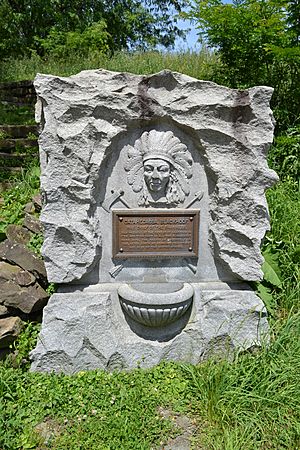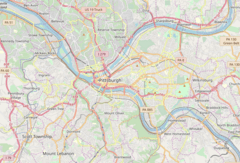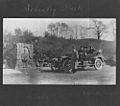Catahecassa (Snyder) Spring facts for kids

The spring in 2019
|
|
| Location | E. Circuit Road (Schenley Park (Pittsburgh)), Pittsburgh, Pennsylvania, USA |
|---|---|
| Coordinates | 40°26′7.82″N 79°56′8.30″W / 40.4355056°N 79.9356389°W |
| Area | Schenley Park |
| Built/founded | 1906-1907 |
| Governing body/ |
City of Pittsburgh |
The Catahecassa (Snyder) Spring is a special water fountain found in Schenley Park in Pittsburgh, Pennsylvania. It's located where E. Circuit Road and Serpentine Drive meet. This spring was built over a hundred years ago, between 1906 and 1907. It is one of only three natural springs left in the city of Pittsburgh.
Contents
The Spring's Story
How the Spring Was Built
People first wrote about this natural spring in 1890. They said it had a lot of water. By 1899, a small stone alcove was built there. The idea for the fountain we see today came after the Fourth of July celebrations in 1906.
There was some money left over from the celebrations. The people who donated the money decided to use it to build a new fountain in Schenley Park. James W. Clark, who was in charge of public works for the city, approved the idea. By September 1906, the plans for the fountain were finished.
Honoring Chief Catahecassa
James W. Clark chose to honor a very important person on the front of the spring. He picked a Native American leader named Catahecassa, who was a Shawnee Chief. Chief Catahecassa was a brave warrior. He said he was at General Braddock’s defeat during the French and Indian War. This was when the British tried to capture Fort Duquesne but failed.
Chief Catahecassa also fought in the Battle of Fallen Timbers. He was the Shawnee representative when the Treaty of Greenville was signed in 1795. This treaty helped end fighting between Native Americans and European-American settlers in Ohio.
A Leader for Peace
In the early 1800s, Chief Catahecassa became known for his work for peace. He believed his people should adopt some customs of the settlers. He wanted the Shawnee society to become more focused on farming. He also refused to join Tecumseh in Tecumseh's War. Instead, he led his people away from conflict.
The fountain in Schenley Park was built to remember his important history. It was finished and put in place by May 1907. The only big change to the spring happened in 1928. Someone damaged the tip of Chief Catahecassa’s nose. It has since been fixed with concrete. In 2016, the spring was nominated to become a City Historic Landmark.
What the Spring Looks Like
Art Style and Materials
The Catahecassa monument was made in a style called Realism. This means it looks very true to life. The fountain itself is made of rough-cut granite stone. It has a special carving on the front called a bas-relief bust of Chief Catahecassa. A bas-relief is a type of sculpture where the figures stick out slightly from a flat background.
This makes it the only natural spring with a decorative bas-relief on its front. The carving of Chief Catahecassa is above a bronze plaque.
The Plaque's Message
The bronze plaque on the spring reads:
"Catahecassa, Blackhoof, war chief of the Shawnees, was present at the defeat of Braddock in 1755 and took part in all subsequent wars until the treaty of Greenville in 1795, after which he remained a friend and ally of the United States."
Gallery





